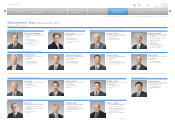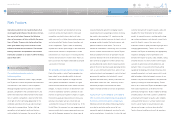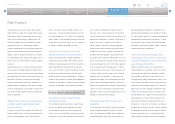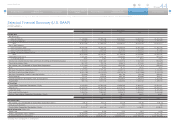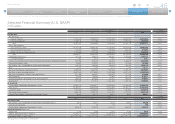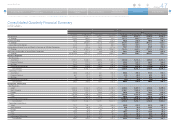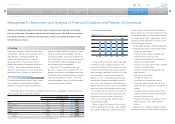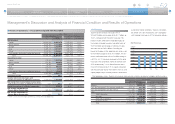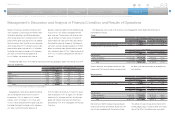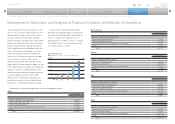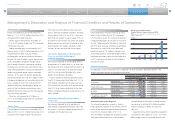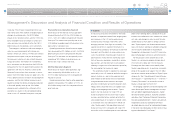Toyota 2014 Annual Report Download - page 48
Download and view the complete annual report
Please find page 48 of the 2014 Toyota annual report below. You can navigate through the pages in the report by either clicking on the pages listed below, or by using the keyword search tool below to find specific information within the annual report.
ANNUAL REPORT 2014
President’s MessagePresident’s Message
Overview of
Four Business Units
Overview of
Four Business Units
Special FeatureSpecial Feature
Review of OperationsReview of Operations
Consolidated Performance
Highlights
Consolidated Performance
Highlights
Management and
Corporate Information
Management and
Corporate Information
Investor InformationInvestor Information
Financial SectionFinancial Section
Page 48
NextPrev
ContentsSearchPrint
Toyota’s vehicles compared with those offered by
other manufacturers. The timely introduction of new
or redesigned vehicles is also an important factor in
satisfying customer needs. Toyota’s ability to satisfy
changing customer preferences can affect its reve-
nues and earnings significantly.
The profitability of Toyota’s automotive operations
is affected by many factors. These factors include:
•
vehicle unit sales volumes,
• the mix of vehicle models and options sold,
• the level of parts and service sales,
• the levels of price discounts and other sales
incentives and marketing costs,
•
the cost of customer warranty claims and other
customer satisfaction actions,
•
the cost of research and development and
other fixed costs,
•
the prices of raw materials,
• the ability to control costs,
• the efficient use of production capacity,
• the adverse effect on production due to the
reliance on various suppliers for the provision of
supplies,
•
the adverse effect on market, sales and pro-
ductions of natural calamities and interruptions
of social infrastructure, and
•
changes in the value of the Japanese yen and
other currencies in which Toyota conducts
business.
Changes in laws, regulations, policies and other
governmental actions can also materially impact the
Management’s Discussion and Analysis of Financial Condition and Results of Operations
All financial information discussed in this section is derived from Toyota’s consolidated
financial statements that appear elsewhere in this annual report. The financial statements
have been prepared in conformity with generally accepted accounting principles in the
United States of America.
The following table sets forth Toyota’s consolidated vehicle unit sales by geographic market based on loca-
tion of customers for the past three fiscal years.
Thousands of units
Years Ended March 31,
2012 2013 2014
Japan 2,071 2,279 2,365
North America 1,872 2,469 2,529
Europe 798 799 844
Asia 1,327 1,684 1,609
Other* 1,284 1,640 1,769
Overseas total 5,281 6,592 6,751
Total 7,352 8,871 9,116
* “Other” consists of Central and South America, Oceania, Africa and the Middle East, etc.
During fiscal 2014 and 2013, Toyota’s consolidat-
ed vehicle unit sales in Japan increased as com-
pared with each prior fiscal year, primarily as a result
of the active introduction of new products and the
efforts of dealers nationwide. For fiscal 2014, Toyota
and Lexus brands’ market share excluding mini-
vehicles was 46.7%, and market share (including
Daihatsu and Hino brands) including mini-vehicles
was 42.2%, each remaining at a high level continu-
ing from the prior fiscal year. Overseas consolidated
vehicle unit sales increased during fiscal 2013 and
2014. During fiscal 2013, total overseas vehicle unit
sales increased in every region. During fiscal 2014,
total overseas vehicle unit sales increased as a
whole, due to increased sales in North America,
Europe and other regions.
Toyota’s share of total vehicle unit sales in each
market is influenced by the quality, safety, reliability,
price, design, performance, economy and utility of
10,000
0
8,000
6,000
4,000
2,000
FY
Consolidated Vehicle Sales
(Thousands of units)
’10 ’11 ’12 ’13 ’14
The business segments of Toyota include automo-
tive operations, financial services operations and all
other operations. Automotive operations are
Toyota’s most significant business segment,
accounting for 90% of Toyota’s total revenues
before the elimination of intersegment revenues for
fiscal 2014. Toyota’s primary markets based on
vehicle unit sales for fiscal 2014 were: Japan (26%),
North America (28%), Europe (9%) and Asia (18 %).
Automotive Market Environment
The worldwide automotive market is highly competi-
tive and volatile. The demand for automobiles is
affected by a number of factors including social,
political and general economic conditions; introduc-
tion of new vehicles and technologies; and costs
incurred by customers to purchase or operate vehi-
cles. These factors can cause consumer demand to
vary substantially in different geographic markets
and for different types of automobiles.
During fiscal 2014, automotive markets pro-
gressed in a steady manner, especially in the U.S.,
although some markets in emerging countries have
slowed down. Efforts toward building a low-carbon
society and improvements in safety, such as the
technical development of eco-cars and automated-
driving, were promoted worldwide.
Overview
Selected Financial Summary (U.S. GAAP) Consolidated Segment Information Consolidated Quarterly Financial Summary Management’s Discussion and Analysis of Financial Condition and Results of Operations [1 of 14] Consolidated Financial Statements



